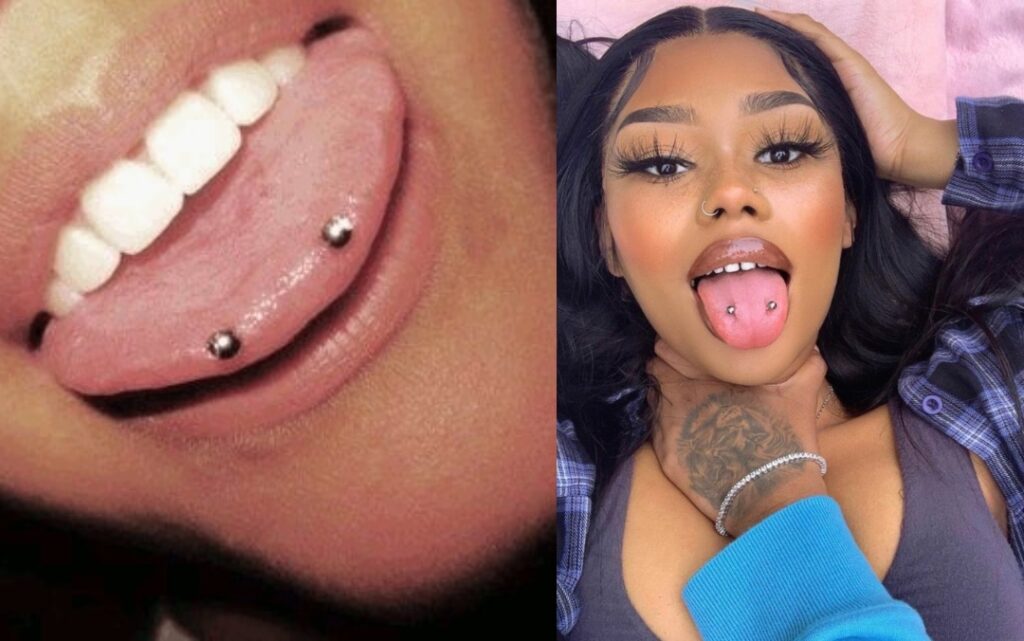Performing a snake eye tongue piercing requires precision, expertise, and strict adherence to hygiene and safety standards. This type of piercing, located horizontally through the tip of the tongue, is both unique and risky, so it’s essential to approach it with care. Below is a detailed explanation of how professionals perform a snake eyes tongue piercing and why it’s crucial to rely on a trained piercer for this procedure.
Steps to Perform a Snake Eyes Tongue Piercing

1. Consultation and Preparation
- Professional Consultation:
- A professional piercer assesses your anatomy to determine if you are a suitable candidate for a snake eyes piercing.
- Some tongues may not have the right structure for this piercing, and forcing it can lead to complications.
- Discussion of Risks and Aftercare:
- The piercer explains potential risks, such as swelling, infection, and possible impact on dental health, as well as detailed aftercare instructions.
- Consent Form:
- You’ll be asked to sign a consent form, acknowledging the risks and agreeing to the procedure.
2. Preparing the Workstation
- Sterile Environment:
- The piercer ensures the workstation is clean and sterilized to prevent contamination.
- Sterilization of Tools and Jewelry:
- All tools, including clamps and needles, are sterilized using an autoclave.
- Jewelry, usually a barbell made of surgical steel or titanium, is also sterilized.
- Personal Protective Equipment:
- The piercer wears gloves, a mask, and other protective gear to maintain a sterile field.
3. Marking the Tongue
- Positioning the Piercing:
- The piercer marks two points on the tip of the tongue where the barbell will enter and exit.
- This ensures proper alignment and symmetry, giving the piercing its “snake eyes” appearance.
- Double-Checking Placement:
- The piercer asks you to confirm the placement marks to ensure satisfaction with the alignment.
4. Performing the Piercing
- Stabilizing the Tongue:
- A sterile clamp is used to hold the tongue steady and minimize movement.
- The clamp ensures precision and reduces the risk of injury during the piercing process.
- Piercing with a Needle:
- A hollow, sterilized needle is used to pierce horizontally through the tongue at the marked points.
- The needle is inserted quickly to minimize pain and discomfort.
- Inserting the Jewelry:
- The barbell is threaded through the hole created by the needle.
- Both ends of the barbell are securely screwed on, ensuring the jewelry is tight but not over-tightened.
5. Aftercare Instructions
- Immediate Cleaning:
- The piercer cleans the area with an antiseptic solution to reduce the risk of infection.
- Aftercare Guidance:
- You’ll receive detailed instructions on how to care for the piercing, including how to clean it with saline solution and what foods to avoid during the healing process.
- They may advise you to rinse your mouth with an alcohol-free mouthwash after eating or drinking.
Why Should Only Professionals Perform This Piercing?

- Complex Anatomy:
- The tip of the tongue contains delicate tissues, blood vessels, and muscles. Incorrect placement can lead to nerve damage, excessive bleeding, or speech issues.
- Sanitation and Safety:
- Professional piercers have access to sterilized equipment and a controlled environment, significantly reducing the risk of infection.
- Experience and Precision:
- Trained piercers understand the anatomy of the tongue and can perform the procedure with accuracy, ensuring the piercing is even and safe.
- Minimizing Complications:
- Professionals know how to handle complications such as swelling or bleeding during the procedure.
Risks and Considerations
- Dental Issues:
- The jewelry can rub against your teeth and gums, causing damage over time.
- Speech and Eating Difficulties:
- You may experience temporary challenges in speaking and eating as your tongue adapts.
- Swelling and Infection:
- These are common risks, but they can be managed with proper aftercare.